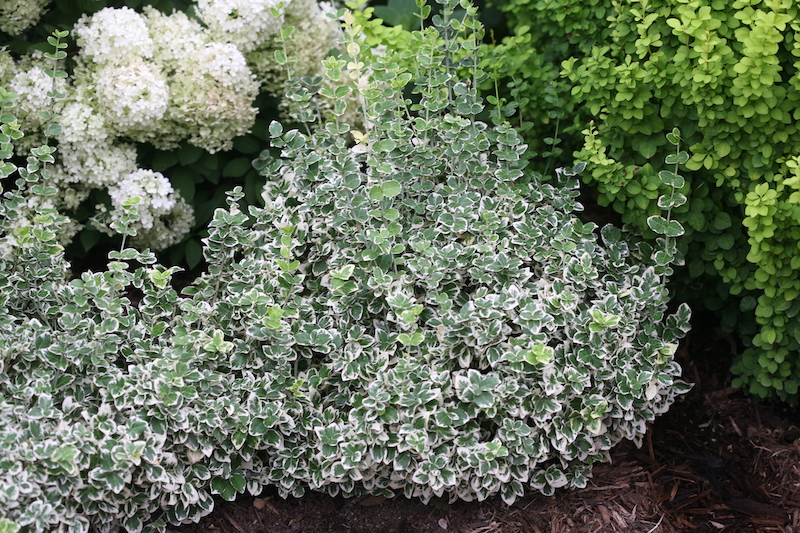Euonymus is a diverse shrub group and comes in many shapes, sizes, and colors, but whatever variety you select, you are in for a show. This hardy plant can be deciduous or a broadleaf evergreen; some cultivars, like Burning Bush, grow about 3 feet tall and have an upright, branching structure, while others, like wintercreeper, have a lower profile and reach about 1 foot tall. Euonymus is commonly selected for its lovely and sometimes showy foliage.
This plant blooms in the spring, but the flowers tend to be plain and not very eye-catching. The flowers give way to berries in the fall, which add visual interest. One of the more popular cultivars is Burning Bush, which earns its name when the foliage turns vibrant shades of red and orange during the fall. Euonymus can be considered invasive, but it is an easy plant to maintain and requires minimal care once acclimated.

Planting Euonymus
Just about any conditions can work for a Euonymus plant, as long as the plant has good drainage. This plant will thrive in full sun and rich soil, but you can still enjoy a full and lush Euonymus plant in poor soil and partial shade. Plants grown in ideal conditions may need more frequent pruning, while plants grown in less than ideal conditions may need assistance in the form of semi-regular fertilization. Either way, established plants are low maintenance and may require attention only a few times throughout the growing season to look their best.
Watering Euonymus
Drainage is essential for Euonymus. This hardy plant cannot handle soggy conditions, leading to root rot. The soil must allow drainage, and container-grown plants must be in a pot with drainage holes. Let the top few inches of soil dry out before giving the plant water. Euonymus is drought-tolerant, but assisting during a dry spell will keep the shrub healthy and thriving. Only water during the growing season and start to scale back during the fall to help prepare the plant for winter.

Fertilizing Euonymus
Quality soil with a high organic content can take the place of routine fertilization as this plant is not a heavy feeder. Nevertheless, feeding the plant can help nurture it and allow it to push out more of its striking foliage. Cultivars like Wintercreeper can benefit from applying slow-release fertilizer once per year. Burning Bush varieties prefer to be fed during the spring and again during the middle of the summer to support sustained growth.
Pruning Euonymus
Euonymus is a plant that benefits from a regular trim, but the extent of the cutting depends on how the plant looks and how you want it to look. Groundcover varieties can be allowed to spread out, but plants with a more manicured, shrub-like appearance can be shaped to have a rounded look. Older plants can be rejuvenated with an aggressive trim. This plant can be invasive in some areas, so some gardeners opt to deadhead to prevent the spread of seed.

Caring For Euonymus in Pots
Potted plants generally need a bit more care than plants grown in the ground, and Euonymus is no exception. While this plant is drought-tolerant, container-grown plants dry out more quickly, so potted Euonymus may need water daily or every few days, depending on the weather. Potted Euonymus needs well-draining soil, and the container must have drainage holes. Place the potted plant in an area that receives full sun to partial shade.
Winter Care for Euonymus
Winter care is very minimal for Euonymus. It is generally unnecessary to cover or protect the plants during the winter. These plants are hardy in winter. Some varieties are deciduous and will drop their leaves, while others are broadleaf evergreens and retain their foliage during the winter. Remove dead or damaged growth during the fall, but the plants should be left alone during the winter, and you can resume watering, fertilizing, and pruning in the spring.
Common Euonymus Care Questions
Why Is My Euonymus Losing Leaves?
Some leaf loss is normal, outside of that, euonymus most often drop leaves due to scale infections or environmental stressors. Such as a harsh winter. Scale can be treated with a strong stream of water to knock them down and Neem oil or an insecticidal soap.
What Causes Brown Leaves On Euonymus?
Summer Leaf Scorch is most often the cause of euonymus turning brown. Too much sun and not enough water to allow for transpiration, leaves the leaves dehydrated, shriveled and brown. During hot periods especially, slow, deep watering can help avoid this and placing mulch around the plant can help hold that moisture in. If heat is extreme, providing the plants with afternoon shade can be beneficial, also.
What Is The Growth Rate of Euonymus?
Euonymus has a moderate rate of growth, and has an annual gain between 1 and 2 feet.
What Causes Euonymus Scale?
A lack of air circulation, too much moisture, and plants that are stressed for any reason leave the euonymus more susceptible to scale infestation. Keeping plants hydrated and fertilized can help combat scale by keeping stress levels low.
How Is Euonymus Scale Treated?
Scale on euonymus can be treated with a strong stream of water to knock them to the ground and Neem oil (which will suffocate the scale) or a commercially available insecticidal soap. Treatment more than once may be necessary.
Have a question about Euonymus? Fill out the form below and we will try and get back to your question as soon as possible. We may even feature your question in this article to help other gardeners!
 |
Author Alison Cotsonas - Published 14-07-2022 |
